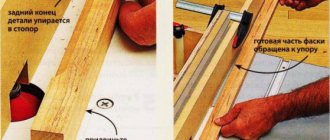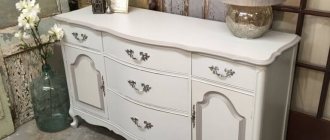Types of hoods
Kitchens can have two types of ventilation: natural and forced. Each option is characterized by both positive and negative properties.
We will not consider the external design; today there is a huge range of models. It is necessary to dwell only on the fundamental differences between the devices. Forced ventilation also has two types.
Exhaust air without cleaning is supplied to vertical ventilation ducts. A flow hood removes air, the pressure in the kitchen decreases, fresh air enters through cracks in windows and doors or from special vents.
The hood has special filters; air is forced through them and cleaned of grease, smoke, harmful chemical compounds and unpleasant odors. Clean air is again supplied to the room.
How to connect an exhaust device to a ventilation rack
Before connecting the hood to the ventilation, prepare everything you need. To combine the hood with the outlet into the ventilation tunnel, corrugated or round PVC air ducts are used.
Option number two is more suitable, as it creates little resistance with the air. PVC pipes are also easier to maintain. Pipe diameter, 130 millimeters. They select it according to the notch of the hood at the outlet. An adapter is used for connection. To properly connect the hood and the air duct, you need to tighten and secure the end of the air pipe in the ventilation duct. When connecting a hood with a duct, the connection will not close the ventilation gap if a protective grille is installed.
Advantages and disadvantages of hoods without venting
Such devices are called hoods very conventionally; in principle, they do not extract or throw anything out, but only purify the air, driving it through themselves.
Due to this feature of operation, there are several important disadvantages.
Recirculating hoods do not affect the percentage of oxygen in the air. If gas stoves are installed in the kitchen, then a continuous flow of fresh air is required, otherwise its concentration may drop to a critical level.
State regulatory organizations will not give permission to connect gas stoves if the kitchen only has an exhaust hood without a ventilation outlet.
A flow is definitely required, and not electric, but natural. The fact is that all forced systems operate periodically, and it is necessary to constantly clean the air from possible gas leaks.
- Hoods without ventilation outlets do not clean the air of pathogens and bacteria, and if the filters are not replaced in a timely manner, the number of these organisms increases sharply.
- Only an influx of fresh air can improve parameters and meet the strict requirements of SanPiN regulations. Regular cleaning or replacement of filters is a prerequisite for using hoods.
It is imperative to remember these shortcomings before making a final decision on choosing the type of hood. But recirculating hoods also have a number of advantages.
- Easy to install. Flow hoods are connected to existing natural ventilation ducts in the building. Such actions require mandatory approval from management companies, and they often refuse.
The reasons are valid - dirty air can get into neighboring apartments, often the unit critically disrupts the efficiency of natural ventilation and creates other problems for neighbors.
Recirculation hoods are completely autonomous; they do not require special air ducts; they can be installed anywhere and in any room.
- Autonomy. The hoods operate without connecting to other devices, do not interfere with their functioning and cope with their tasks. A natural ventilation system can operate in the kitchen without interference; installing a recirculation system does not affect its parameters in any way.
- Reducing heat losses. In supply systems, warm air is exhausted outside, and instead cold air enters the room. This exchange greatly increases the cost of maintaining comfortable microclimate temperatures.
As you can see, the number of positive and negative sides is almost the same. Make decisions based on the specifics of your kitchen.
Important. If you use a gas stove in your kitchen, then always follow the safety rules, especially the requirements for the frequency of air exchange in the premises. Remember that the vast majority of explosions in apartment buildings occur due to a malfunction of the ventilation systems.
If they are in good working order and the technical parameters meet the standardized values, then the gas that has entered the room is removed, and the probability of an explosion is reduced to zero.
Types of kitchen hoods
Modern manufacturers keep up with the times. There are many options for ventilation systems with different functionality. A high-quality assistant can not only quickly eliminate unnecessary odors, but also prevent the appearance of soot and sticky grease deposits on your favorite furniture.
Taking into account the specific parameters of the room and our style preferences, we can select certain designs.
Hanging
Inexpensive and common option. Installation takes place directly above the kitchen stove. The equipment includes a motor, fan and filters. The mechanism sucks in air, purifies it and releases it into the environment. Filters need to be changed when they become dirty. The design is compact and does not have a connection to the ventilation system. Will fit even in the smallest kitchen.
It is quite possible to use this simplest option
Built-in
The laconic design is mounted together with the cabinet, which is located above the stove. It has a telescopic fragment, which allows you to significantly increase the working surface area of the unit with one movement of the hand. Can be used with a connection to ventilation, or with the use of cleaning filters.
For lovers of built-in technology it will be indispensable
Dome
They are one of the powerful units. They should be used when arranging large kitchens. They have a wide range of design solutions to suit every taste. They work most efficiently due to their ventilation.
The dome system is well suited for air purification
Corner
Allows you to apply non-standard planning solutions when decorating the kitchen space. Now important equipment can be placed in any corner and provide a comfortable atmosphere without compromising the decor. Such a hood can even be built-in or domed.
Design solution for air purification in high-tech style
Island and T-shaped hoods
Work effectively over large areas. Technical features allow you to mount the unit on the wall, on the ceiling, near the stove or above the stove. Refers to high-power systems.
A properly selected design not only cleans the air, but also gives the room a complete look.
Hoods are distinguished according to their operating principle.
Read the review of models of hoods without venting, and also study the selection rules in a special article on our portal.
Standard type, also known as flow-through
Requires mandatory connection to the general building ventilation system or installation of a separate outlet to the street. The latter is especially relevant when carrying out work in old houses.
A heavily polluted or narrow air shaft will not allow even the most advanced design to operate at full capacity. Accordingly, one cannot expect more or less high-quality results without dedicated ventilation.
The problem is not so significant when it comes to the kitchen in a new home. If the ventilation is working properly, you just need to connect a new device to it.
More often found in dome hoods.
Recirculation type
Used in mounted and built-in units. The device filters the air, absorbing steam and foreign odors. In the most advanced models, cleaning involves two stages. At first, the air passes through the filter, entering the internal tank. This is how heavy particles such as fat, soot and soot are captured. Next, a fine carbon filter is put into operation. It is responsible for removing unpleasant odors.
Combined type
Such progressive devices make it possible to use one of two types of work depending on the situation. Switching makes the hood universal, convenient for frequent moves.
Remember to regularly replace or clean filters
Video - Choosing a kitchen hood
Prices for kitchen hoods
Kitchen hoods
What characteristics must kitchen hoods without connecting to ventilation meet?
Let's check what you pay attention to when choosing such necessary household appliances as a ventless kitchen hood, and what parameters you should actually give preference to.
Whether the design will be useful or will become unnecessary kitchen trash depends on how correct the appearance is, as well as what options the equipment will have.
Best Performance: How to Determine
The performance of the appliance is a number that results from the efficiency of processing polluted air in the kitchen area. To determine it, you need to be guided by a special formula.
- To do this, multiply the entire volume of the kitchen (this includes area, ceiling height, number of optimal processing cycles) by the error factor (1.7).
As a result, you get a performance value specifically for your kitchen.
Availability of filters and their quantity
Traditionally, in hoods without the ability to connect to ventilation shafts, there are two types of filters: external (grid) and internal (carbon), which directly does all the work of purifying the air.
The grease trap (or external filters) is made of stainless steel or acrylic material.
In addition, inexpensive models are made with non-woven or paper grilles, which have to be changed frequently. More expensive models of kitchen hoods without outlets have several stages of carbon cleaning. Such units are more suitable for rooms with an area of 30-35 m2.
Hood with ventilation outlet: parameters and selection criteria
Having decided on the design of the device and the design style of the room, we proceed to the most important stage - selecting a kitchen hood. When choosing a household unit, it is important to consider the location of the gas or electric stove in the kitchen. As for the selection criteria taking into account the technical characteristics and parameters of the device, this issue is worth dwelling on in more detail.
Modern hood in the kitchen interior
Performance
Performance is one of the main characteristics of the device, by which its ability to remove a given volume of air per unit of time (in 1 hour) is assessed.
This parameter is easy to calculate independently: the area of the room is multiplied by the height of the room and the final value is multiplied by 10. Based on the resulting figure, the need for hourly oxygen renewal is judged.
For studio apartments, it is better to purchase units with a power reserve
Experienced experts recommend multiplying the calculated value by 1.3. Using the specified coefficient, a more accurate performance of the unit is obtained, where the presence of contaminants and the length of the air channel are already taken into account. Obviously, it is better to purchase a model with a 15-20% performance reserve, because... A device that constantly operates at the limit of its capabilities quickly exhausts its intended resource and makes a lot of noise.
Kitchen hood with ventilation outlet - dimensions
In the case under consideration, they are guided by a simple relationship - the area of the working area of the hood must correspond to (and sometimes slightly exceed) the area of the stove or hob. Everything is obvious here - a small hood does not have enough power to remove the entire volume of polluted air. As a result, the kitchen will always be filled with steam from cooking food, particles of fat, and a sticky layer will certainly form on the furniture.
Kitchen hood with retractable work surface
Noise level during operation
Each household appliance makes a certain noise when operating. It is measured in special units - dB (decibels). Each person has an individual sound sensitivity, and therefore each person has their own reaction to noise. Values in the range from 35 to 50 dB are considered comfortable.
A quiet conversation between 2 people is audibly within 40-45 dB, taking into account a distance of 2-3 meters. If you approach the source of acoustic waves by 1 meter, the value will increase to 60-65 dB.
Noise levels
The limit value is 70 dB at maximum fan speed. Almost all modern devices equipped with reliable electric motors have the appropriate technical data. Despite their higher cost, this is the case when the price is completely justified. However, if noise is not important, then it is better to take a closer look at more affordable units.
Control Panel
The ease of working with a household device also depends on the control panel. In the case of a hood, this is either a push-button control or a touch panel. Modern models are equipped with a number of sensors that monitor humidity and temperature in the working area. Taking into account the received data, the device automatically switches to the optimal operating mode, which is very convenient and practical.
Kitchen hood with touch control
When purchasing a unit with mechanical control, we recommend that you evaluate the convenience of placing controls and buttons on the front panel of the device. The main criterion is to be in line of sight, which will allow you not to be distracted from preparing dishes every 2-3 minutes.
In terms of ease of use, systems with programmable electronic control are unrivaled. Having installed the program and adjusted its operation just once, in the future it will be enough to simply select it from the available list.
Island hood with ventilation outlet
Housing materials
Hoods with bodies made of 3 main materials are available for sale. Budget models are equipped with metal structures decorated with enamels. These solutions are durable and look beautiful, but they require careful maintenance and careful operation.
The most expensive and elegant are devices made of polished stainless steel. They are distinguished by their structural lightness and ease of maintenance.
The hood is formed from modules built into the ceiling and connected to a remote filter
The main material for the housing of type 3 devices is tempered glass. This option can be safely recommended to owners with refined taste. Such devices look stylish, but cleaning them requires time and certain skills, because... marks and stains remain on the glass surface.
Before purchasing, it is important to decide on the main parameters of the device, to distinguish among them the primary and secondary ones. It is necessary that a household appliance combine functionality and an appearance that matches the interior.
What additional options can be equipped with coal hoods?
Each kitchen device, designed to effectively purify the air after cooking, has a number of additional capabilities that add ease of use. Let's take a closer look at these “gadgets”.
- The presence of a monitor on the kitchen hood will help make sure that you have set the operating mode of the appliance correctly.
- Timer. This is one of the practical secondary functions that will allow you to set up work on a schedule, that is, determine the exact time for how long the device should work.
- Electronic display. With such a device, you will always know in which mode the coal hood is operating, in addition, the monitor will report an error if something happens.
- Light indicators and graphic designation. With the help of such a signal, you will be able to understand at what level of contamination the filters of the cleaning system are, so you will not forget to change them in a timely manner.
- Built-in sensors. It would be good if the device had the ability to turn off and turn on automatically when the air in the kitchen is saturated with food vapors and grease.
- Periodic launch mode. This additional function is acceptable if it is necessary to regularly maintain clean air in the kitchen.
- Possibility of remote control. Having a remote control for your coal hood, you will no longer have problems with disputes about who will start or turn off the system. Now this is done by lightly pressing a button on the nearby remote control (the main thing is that it is at hand).
A hood with a remote control will allow you to start the appliance if you are on the far side of the kitchen.
Types of kitchen hoods
All household hoods must pump an amount of air equal to 10 times the volume of the kitchen per hour. This requirement is contained in sanitary standards; it is based on the fact that heating devices are operating in the kitchen, there is often an open flame, food is being prepared, and there is increased humidity. All these devices contribute to the accumulation of carbon dioxide, water vapor, and foreign odors in the room.
Sanitary standards require the organization of exhaust air removal
If you look at the grille of a kitchen hood that has been running over the stove in an average family for a month, you can see a significant amount of dirt. Obviously, without this device, all the dirt would have settled on the furniture, ceiling and utensils. High humidity contributes to premature destruction of furniture and spoils the finish of ceilings and walls. At high temperatures and open flames, the oxygen content is significantly reduced.
So much dirt accumulates on the ventilation grille
Contaminated air must be removed. This goal is achieved in two ways: removing dirty air outside and replacing it with clean air or circulation filtration.
a) Recirculation b) Removal of exhaust air with an influx of fresh air
With bend
Kitchen hoods with ventilation outlets are the classic and most common appliances that are installed in close proximity to the stove as the main source of pollution. The air intake hood is equipped with a special removable grille, on which droplets of grease and dust settle. This is necessary to prevent dirt from getting into the common channel. Ventilation is usually forced, using a built-in fan.
Removing air through the vent using an exhaust fan
To operate such a hood, it is necessary to ensure an inflow, since the outflow of air is significant. In the absence of an inflow - a window or a special supply duct - a so-called overturning occurs when air from the ventilation duct itself begins to be sucked into a room with a rarefied atmosphere.
Hood that connects to the ventilation duct
Related article:
Plastic air ducts and fittings for ventilation. A separate review provides useful information on the use and types of fittings for plastic ventilation.
Without recusal
Kitchen hoods without venting into ventilation are powerful air filters. They are also mounted near the slabs, but have smaller dimensions. In addition to the removable grille and fan, their design includes filtration systems:
- a coarse filter that retains moisture, drops of grease and household dust, is a small plastic or aluminum removable grille;
- a carbon filter that removes microparticles, absorbs water vapor and odors, this filter is designed for about a month of use, after which it must be replaced.
Circulation hood
The performance of such a cleaning system meets sanitary standards, but to achieve it it is necessary to use more powerful electric motors. Over time, as the filters become dirty, performance decreases. The carbon filter cannot be cleaned and must be discarded and replaced with a new one.
Carbon filters for kitchen hoods
Types of hoods by design
The stove can be located in different places in the room, even in the middle. Therefore, hoods can have different designs depending on the location of the stove. The following main types are distinguished:
- corner;
- wall;
- island.
Various designs of hoods depending on the location of the stove
Wall-mounted options are the most popular due to the classic slab layout. They can have a variety of dome shapes.
Classic wall hood
Island - located above a free-standing slab, which is not adjacent to the wall, and is attached to the ceiling using a cable or a special pipe. Most often they have a dome shape to capture more steam. In accordance with the design idea, they can be a real decorative element of the room.
Island style kitchen hood with storage space
Built-in hoods are used for small spaces and are mounted in a decorative box or built-in cabinet in a kitchen unit. Most often they are equipped with a special retractable panel to increase the working surface. The main advantage is saving space while working efficiently.
Built-in hood with retractable panel
Reputable manufacturers of hoods without vent outlet
The standard for the quality of kitchen exhaust hoods is not easy to find today, however, our editors will help you solve this problem.
We bring to your attention truly conscientious manufacturers who do not skimp on quality.
Ariston is one of the legendary companies
It specializes not only in the production of kitchen hoods, but also a large volume of necessary household appliances. It is believed that this brand is becoming a leader in the Russian market based on sales results analysis.
Bosch - consistent quality
The company has been famous in the market for many years. The equipment is assembled strictly in Germany, and the finished device is more than reliable.
The design does not have a specific design, so the devices are completely different from each other.
Gorenje - equipment originally from Slovenia
The Slovenian brand offers irreplaceable hoods based on a carbon filter. The company has been specializing in such devices for a very long time, and accordingly, it has managed to get its hands on it and boast of impeccable quality.
Electrolux - covers all needs
The declared trademark is ideal for the production of ventilation systems in the form of hoods.
Such units are available all over the world, so you can become the owner of a branded unit even if you live in distant countries from the place of assembly.
Advantages and disadvantages
Usually, a hood with an outlet is installed only for a gas stove, since due to open fire it is the one that produces the most soot and grease. But such a hood will also be justified with, for example, an electric or induction stove - there are a number of advantages:
- environmental friendliness - the room remains fresh, the air is purified, but the environment does not suffer from this. The air is released with a large amount of carbon dioxide, but without coarse impurities, fat and soot;
- profitability - manufacturers took care of this factor. Now there are many models on the market with efficiency class A+ and higher;
- health - clean air has a positive effect on a person compared to polluted air;
- easy maintenance - filters are easy to remove and wash, and if necessary, easy to replace;
- versatility - there is such a variety of models on the market that the equipment can fit into any interior;
- noiselessness - modern models are so quiet that they will not disturb neighbors even during long-term operation;
- power - clean and fresh air in just a few minutes is possible thanks to forced ventilation.
Yes, there are many positive aspects when installing a hood with a ventilation outlet, but there are also negative aspects. The main factor is the need to install an air duct. This will make the ceiling heavier and will also require additional cash costs.
Most often, an electrician is needed for proper installation, since independent installation can lead to incorrect operation or even breakdown of the equipment. And the price of exhaust hoods itself is significantly higher than circulation models.
When a coal hood without venting into the ventilation is indispensable for the kitchen
A hood without an air duct is famous for its simple and, most importantly, quick installation, so at any time, as soon as you realize that you cannot do without such a device, you can purchase it.
If you still have not answered the question why it is not recommended to use a flow-through ventilation system in your case, then be sure to read the points below.
- If you unknowingly bought a hood with insufficient functionality, you will also have to acquire a flow-through unit.
- An inoperative ventilation duct or its complete absence (often this does not exist in private houses).
- The interior and size of the room does not allow it.
- The hob is located too far from the fixed vent, which requires long duct pipes.
- The presence of reverse draft in the ventilation ducts (this occurs due to installed boilers or gas water heaters).
Do not be upset if in your kitchen conditions the installation of a ventilation system with a pipe turned out to be irrational. A circular device will serve you well, especially since it requires minimal maintenance, which you can do yourself.
Question No. 8. For what cases is this ideal?
The main reason to install a recirculating hood is the inability to vent polluted air into the shaft or outside. There are several reasons for this:
- the mine is too far from the intended installation site of the hood, and there is no desire to build labyrinthine paths from corrugated paper;
- there is a shaft, but there are problems with the ventilation, for example, all the air with aromas gets to the neighbors;
- there is no shaft at all or there is no hole in the kitchen;
- the presence of reverse draft in ventilation (for example, when gas boilers or water heaters are installed) - the use of a standard hood here increases the risk of carbon monoxide poisoning;
- The air duct does not fit into the design.
The conclusion suggests itself is the following: a hood without an outlet should be chosen only if there is no possibility of making a hood with an outlet, since the latter is much more efficient and has a simpler operating mechanism.
Exhaust hood in the ventilation system of the kitchen and apartment as a whole
It should be correctly understood that regardless of whether you plan to install a hood in the kitchen at all, or which model is chosen, the kitchen must remain included in the general ventilation system of the house or apartment.
And one more thing that should never be forgotten. For high-quality ventilation of apartments or residential buildings, the following scheme is usually used.
The flow of fresh air is carried out through the premises of the living area - for this purpose, supply channels and valves are provided. And the exhaust air, instead of the incoming fresh air, is removed from the kitchen, toilet, bathroom, or combined toilet.
If the ventilation is planned correctly and works correctly and efficiently, then the odors and fumes inherent in the rooms through which the exhaust is carried out do not enter the living rooms.
This ventilation can be carried out according to natural, forced or mixed (combined) principles.
Natural ventilation in the kitchen is the mandatory presence of an vent through which air is drawn out naturally. This approach has one important advantage - it does not require any material costs, and if the draft in the ventilation exhaust ducts is sufficient, then nothing else is required.
But, of course, during intensive cooking, it is impossible to immediately remove all the odors and fumes rising from the stove into the ventilation duct. And this is where the kitchen hood comes to the rescue, helping, but in no case replacing ventilation.
The forced system involves installing fans in supply valves and/or exhaust ducts. This is done if there are difficulties in creating conditions for natural air circulation in the required volumes.
Forced ventilation is more productive, but, as mentioned above, it requires the installation of additional equipment that depends on the availability of electricity. That is, considering it in its pure form is wrong!
The presence in the kitchen of a hood with forced removal of fumes from the stove to the street or into the ventilation duct is, again, considered only as a “help” for the main ventilation, but not as a full replacement.
The third, combined option would be optimal, combining natural and forced air exchange patterns.
In this case, supply natural and exhaust forced ventilation can be used, or vice versa. At the same time, it is possible to operate in the absence of power supply. For example, a fan installed in a duct should not be an insurmountable obstacle to the natural flow of air.
Typically, such combinations require the presence of special valves that automatically switch the operation of the channel to forced, for example, with a kitchen hood turned on, or natural ventilation mode.
So, we figured it out: a hood above the stove is an excellent assistant to the overall ventilation system, but is by no means a replacement for it.
Types of filtration exhaust devices
The variety of recirculating kitchen hoods is not inferior to classic flow-through devices.
We recommend that you read: Installing a proper ventilation system in a private home
Depending on the location and method of installation, the following types of exhaust devices are distinguished:
- mounted horizontal;
- vertical;
- slider;
- built-in;
- island.
Hinged horizontal hoods without removing air masses are mounted in the classic version - openly placed above a gas or electric stove. Their big advantage is their small size, which allows you to place elements of kitchen furniture at the top.
Vertical recirculating hoods for the kitchen can be called an innovation in this segment of household appliances. They are mounted behind the stove or in the countertop. If necessary, place it in the working position - vertically, at a slight angle, behind or to the side of the burner area.
Telescopic (slider or retractable) kitchen hoods have reduced dimensions in the non-working position. When you turn on the device, its working surface doubles due to the retractable panel.
Built-in models allow you to preserve the design while being placed inside a wall-mounted kitchen cabinet. In this case, the cabinet itself can be used completely for its intended purpose, since there is no air duct.
Island models of recirculating hoods amaze the imagination with their variety of shapes and sizes. Mount them above the kitchen stove, attaching them to the ceiling. The absence of an air duct allows you to “mask” the hood without venting it under the decorative elements of the room.
Filters for hoods operating in recirculation mode
Hoods operating in air purification and recirculation mode are sometimes called coal hoods. This is not entirely correct, since their design, as we have seen, essentially does not change.
But cleaning the air pumped through the device is impossible without a carbon filter.
The filter is a plastic or metal cassette of rectangular or round shape, the internal space of which is filled with activated carbon.
Some models additionally use synthetic material impregnated with the same coal.
Carbon filters work effectively for three to four months with active use of the hood. But the manufacturer indicates the exact operating time in the instructions included with the product.
Some modern models of hoods are equipped with a self-diagnosis system, which shows how much the carbon filter's resource has been spent. That is, it is easier for the owners of the device to keep the situation under control.
Another mandatory filter that a hood cannot do without, regardless of its operating principle.
We are talking about a grease trap. If you do not install it, then after a very short time all the insides of the hood, including the fan blades, valve flaps, and duct walls will become overgrown with a thick fatty deposit, which will be extremely difficult, if not impossible, to remove.
The grease filter is located directly at the entrance to the device.
It can be a thin metal (aluminum) mesh, in the cells of which fatty fumes are retained. Another option is fabric or paper liners, which are also effective at trapping fat.
Thus, grease particles from the steam rising from the stove remain on this filter, and unpleasant odors and other contaminants are finally “cleaned out” in the coal filter.
The mesh metal grease filter must be cleaned approximately once a month.
As a rule, these hood parts can be washed well in the dishwasher or by hand, with preliminary soaking in hot water with the addition of a detergent that does not contain abrasive ingredients.
From time to time, such filters are replaced with new ones, which can be purchased in one of the specialized stores or on the Internet.
By the way, they can be original, that is, produced by the hood manufacturer, or universal, which are suitable for various models. The cost of the latter is somewhat lower than the original products, but the quality, it must be said, is “thinner”.
In paper or fabric grease filters, the inserts are replaced with new ones.
The problem with filters, by the way, is one of the most serious. Many homeowners who once previously made their choice in favor of a kitchen hood operating on the principle of recirculation have already regretted it.
The efficiency is still not the same as with complete removal of vapors, and the frequent need to replace filters, which sometimes may not be found in the store, begins to irritate.
And therefore, there are quite common pictures when the owners gave up on this matter, stopped changing carbon filters, and are content with natural ventilation. And the hood itself is not removed above the stove only because they are already accustomed to its presence and the fact that it provides illumination.
So you need to think in advance...
Connecting a kitchen hood to ventilation - step-by-step instructions
If you decide to connect the hood in the kitchen yourself, then you should carry out a number of preparatory work. You may need to purchase missing parts. This can be an air duct, sealant, metal tape, adapters and clamps.
Step 1. Prepare for connection.
The preparatory stage should include choosing a method of connecting to ventilation. They either connect to a general ventilation system, or make an independent exit to the street for exhaust. In the latter case, it is advisable to carry out this work at the stage of renovation of the premises.
Air duct for island hood
- We take careful measurements.
Marking for the ventilation hole in the wall
- Drilling a hole for the air duct.
Diamond Drilling Motor Prices
Diamond Drilling Motor
A properly prepared hole in the wall is the key to effective operation of the exhaust system.
- If the ventilation pipe is routed through the wall, you should think about designing it from the outside. A pipe and a grille or cap are installed to prevent the entry of foreign objects, debris and insects.
Arrangement on the street side is a safety measure
Attaching the hood to the wall. Carry out according to the manufacturer's instructions.
Step 2. Connection to the ventilation system.
Preparation of materials. Various types of pipes are permitted for this purpose. This can be a metal corrugated pipe, corrugated plastic, a stainless steel pipe (round cross-section), as well as plastic with a rectangular or round cross-section.
The list of necessities will include a clamp, metal tape, and a ventilation grille for entering the general system of air shafts at home.
- Assembly of pipes and preparation of corrugations.
The pipes are hermetically fixed with metal tape
- Fixing a pipe or corrugated air duct.
Fix the desired section of the air duct in the hole made
- Relevant in case of creating a separate ventilation outlet for the exhaust system.
When using corrugation, secure it with a clamp to the ventilation grille
- Connecting the pipe to the hood. For this purpose, it is convenient to use metal tape or a clamp.
Tightness is fundamentally important
Step 3. Final work.
- Connection to the power supply network.
If the hood has wires, you need to connect them to the power cable.
If there is a plug, connect to a pre-selected outlet
- Installation of a decorative box.
The box hides the functional elements of the hood, fastenings and wires
A properly installed hood forms a single whole with the air duct. Works without unnecessary noise and at full power. To check the operation of the equipment, the hood is turned on and the indicators are assessed according to the manufacturer’s instructions.
Video - Exhaust and ventilation: the best combination
Device noise level
This parameter is also important, since the comfort of using the device depends on it. Therefore, it is also necessary to pay attention to it.
Noisy operation is a significant drawback of many models. In the product data sheet, the manufacturer usually indicates the noise level of the fan installed in the hood.
If the noise level is not higher than 45 dB, then the device is quite suitable for a standard-sized kitchen room. For a more spacious room, you can choose a model with 55 dB, but no more, otherwise you simply won’t want to turn on the hood because of the discomfort it causes.
The efficiency of the device, as well as the level of noise emitted, depends on the selected speed mode.
Most exhaust hoods are equipped with a three-speed operating mode, but there are models with five speeds. Accordingly, the higher the speed, the louder the noise of one or two fans running.
The lowest noise level is 40 dB, it will not cause discomfort to apartment residents, but when choosing this version of the device, you will have to sacrifice its performance.
And one more thing - noise can increase during operation due to vibration and resonance phenomena. As a rule, the reason for this is errors in the installation or assembly of the device. There should be nothing loose, rattling, etc.
Operating principle and device features
A typical kitchen hood is a fan that sucks in air and forces it into the duct. Air duct - connects to the ventilation shaft of the house (less often - directly to the street).
A hood without an outlet is not connected to the air duct. In fact, it is not an exhaust device, but a filtration device, that is, an air purifier. In this case, the air is not removed from the kitchen, but is recirculated in one room, which is why such devices are called recirculation devices.
A two-stage filtration system is installed in the case (more about it below). Having passed through 2 filters, the purified air is not removed through the ventilation shaft, but is blown back into the kitchen. It enters the room through openings that can be located on the sides, top, or at the front end of the housing.
Some models have a protruding box above the body on which holes are located. In this case, the escaping air will enter the upper part of the room, where it will not interfere with anything (nothing will be blown off the table or shelves).
Otherwise, recirculation models have the same structure as conventional hoods. They may have backlighting and speed adjustment. Models may also differ in placement:
- Mounted. This device is mounted on the wall above the stove.
- Built-in. In this case, the product is “hidden” in a cabinet that hangs above the stove.
- Island. They are attached not to the wall, but to the ceiling. Relevant if the stove is not located close to the wall.
- Angular. Can be mounted in the corner of the room.
Operating principle (video)
Pros and cons: is it worth choosing?
Devices of this type have the following advantages:
- the ability to use a hood where it is impossible to connect to an air duct or vent to the street;
- comparatively cheap: recirculation models are cheaper than conventional hoods (with an air duct), and there is no need to spend money on additional parts (air duct and cabinets to hide it, brackets);
- the sizes of such models are usually smaller than those of conventional hoods;
- if there is a ventilation shaft hole in the room, it will not have to be occupied by the exhaust air duct (as a result, the air exchange in the room will not be disturbed);
- ease of connection: there is no need to install an air duct, so installing them is easier, faster, and takes up less space (installation is discussed separately below);
- for long-term operation of such a hood, no air flow is required, since it is not removed from the room (a conventional hood removes air, which means there must be an influx of air, which can be problematic in the cold season).
The last advantage is controversial, it can also be considered a disadvantage: air flow into the room (for human breathing) is still required even in winter. In addition, with constant recirculation of air (which contains moisture particles), the humidity in the room will increase.
Hood without venting
As a result, if you only “drive” the air with a recirculating hood and do not allow fresh air to flow in, the room will be stuffy. Over time, mold may appear.
In addition, such devices have other disadvantages:
- Frequent replacement of filters is required, which are expensive and cannot be cleaned (more about filters below);
- a small selection of models: there are several times fewer recirculating hoods on the market than conventional ones;
- more noise: to “push” air through the carbon filter, you need a more powerful (and therefore noisier) engine;
- if the filters are of poor quality, not only odors can remain in the room, but also particles of grease (and since the air is blown out under pressure, grease can settle throughout the kitchen, on furniture, floors and walls);
- not ideal efficiency: even a newly installed filter will not completely remove odors from the air if they are very strong.
In what cases is it useful to use?
It is better to use such a device in cases where there is no possibility of venting polluted air into the mine:
- the ventilation shaft hole is located too far from the installation site of the hood;
- the operation of natural ventilation is disrupted, due to which the air removed by the hood (and odors) can reach the neighbors (this problem is not uncommon in old houses);
- there is no ventilation shaft in the house at all (or there is no hole in the required room);
- there is no space for laying the air duct;
- a large hood or air duct does not fit into the kitchen design.
The conclusion can be drawn as follows: you should choose recirculating hoods only in cases where there is no possibility of using conventional models (with an air duct). The conventional exhaust mode is much more efficient and simpler than the recirculation mode.
As an option, if there is no way to install a conventional hood, you can install a model with recirculation, and to improve ventilation in the room use:
- wall supply valve or installation (to provide fresh air);
- an exhaust fan (in the wall, blowing directly onto the street or into the ventilation shaft), and it is recommended to install it as close as possible to the hood and turn it on simultaneously with it.
Island (ceiling) hood without outlet
This solution is also suitable for those who have already installed a hood without an outlet, but are disappointed in its effectiveness.
Description of filters and care rules
Recirculating hoods have two filters:
- Grease trap. The standard filter for any hood is a metal mesh through which the air passes first. Serves to trap large particles. Requires cleaning periodically. Less commonly (usually in the cheapest models) anti-grease filters made of other materials are found.
- Carbon filter (absorption, anti-odor). Serves for finer air purification from small particles and odors. It cannot be cleaned, only replaced with a new one.
The anti-grease filter is cleaned as it becomes dirty. It is advisable to periodically look at its condition and, if necessary, remove and wash it.
Since the carbon filter cannot be seen, it is replaced:
- After a certain period of time.
- If the operation of the hood has deteriorated (it has become worse at “pulling” air, it’s worse at cleaning it, and it makes more noise).
- Some models (more expensive ones) have a sensor that indicates when the filter is dirty and needs to be replaced.
Carbon filters for hoods
The timing of replacing a carbon filter is always individual and depends on the following factors:
- on the quality of the filter element itself (cheap models will clog faster than higher quality ones);
- depends on what kind of food is prepared and how often: if you cook borscht and fry meat every other day, then the filter will quickly clog.
On average, the service life of a set of carbon filters ranges from 2-3 weeks (with frequent preparation of “heavy” food) and up to 3-4 months (with less frequent use and preparation of not too fatty and aromatic dishes).
By cost
: 1 carbon filter can cost approximately from 250 to 700 rubles (average range). It’s easy to calculate that if you change it once a month and buy the cheapest option, then over the course of a year it will cost an additional 3,000 rubles.
2in1 - hoods with air duct and recirculation mode
Now you can find 3 types of models on the market:
- Conventional hoods with an air duct that remove air from the kitchen.
- Recirculating hoods that purify the air and return it to the kitchen.
- Models with an air duct with a recirculation mode. They can be used both as a regular hood (which will remove air) and as a recirculation hood.
The difference between a hood with outlet and a model with recirculation
The third option appeared relatively recently, and the range of such devices is not very wide. Connecting the air duct is only necessary to remove air - that is, if you plan to use the hood only in recirculation mode, then it is not necessary to install an outlet.
Models of this type are not particularly popular, and in fact are of little use for the following reasons:
- they cost more than products with one function;
- The recirculation mode is less efficient than a conventional hood and is therefore unlikely to be used in practice.
The principle of operation of hoods in recirculation mode
In principle, there is no particular difficulty in the operation of such devices.
- Air contaminated with vapors and odors is drawn in by the fan through the working panel of the hood.
- At the inlet, the air immediately passes through a grease filter.
- The air flow is then passed through a carbon filter, which removes odors and remaining contaminants.
- The purified air is discharged back into the room through the openings (windows) provided in the device body.
The drive unit, without which the operation of the hood in recirculation mode is in principle impossible, is a motor and a fan.
Some hood models are equipped with two motors, others have one motor, but it is reinforced by two fans mounted on the sides. For dome hoods, the fans are located above the filters, inside the housing, and for flat models built into furniture, the fans are located between the filter elements.
A grease filter is always used for any method of installing the hood. But coal ones, which are more expensive and require regular replacement when venting air outside, are not needed, and their “nest” is simply left free.
By the way, when the hood is connected to the ventilation duct, it is often able to cope with its task even without turning on the drive - good natural draft is enough.
When operating in recirculation mode, this is impossible - without applying additional forced efforts, evaporation cannot be pumped through the filters.
The hoods presented in Russian stores operate on a 220 V power supply. Therefore, before installing the device at the place of work, it is necessary to provide a separate outlet for its connection.
Usually it is placed discreetly, for example, above the upper wall cabinets.
There is, however, an important nuance. The kitchen is a room with high humidity. And the body of the vast majority of hoods is made of metal. And in the event of a phase breakdown on the housing when touching the hood, you can get a very dangerous electric shock.
Therefore, the line to which the hood is connected must be equipped with an RCD or circuit breaker. However, this applies to all appliances located in the kitchen area.
Circulation and drainage: what is it and why is it important?
During the cooking process, a lot of steam, droplets of fat, odors are released, and walls, dishes and furniture become covered with a coating that is difficult to remove. A hood will solve this problem. There are two main types of this technique:
- recirculation;
- with outlet to ventilation.
The first type absorbs air, filters it and returns it back to the room. The second one simply takes air from the room and takes it outside through the wall (in a private house) or into a common ventilation duct (in an apartment building), so the work of the exhaust is considered more effective - the air is purified by 99%.
How to choose?
In order for your choice to be worthy and the model to be functional, it is worth knowing a few nuances about choosing a hood without an air duct:
Hoods vary in their performance, so it is especially important to take this indicator into account.
There is a simple formula that allows you to calculate the required performance of a particular model: multiply the kitchen area by its height and multiply the result by 12 - the answer is ready. By the way, manufacturers of hoods often write in the characteristics of the model about the size of the kitchen it is intended for, and the consultants in the appliance store will definitely help you with such a confusing choice.
- The size of the hood is an important parameter; it is usually equated to the power of the model: the higher it is, the larger the hood itself and the more noisy it is in its operation.
- If the kitchen is small and you do not cook very often, give preference to a smaller model and enjoy its measured and almost silent operation.
Choose the latest models of hoods: this will allow you to purchase a modern model, perhaps less noisy (up to 40 dB) and more functional. Interestingly, there are models with a remote control for the hood.
Can't choose a model among brands?
Think about what kitchen appliances you have and evaluate how satisfied you are with them. Now think about a range hood from the same brand or try Krohn, a German manufacturer that specializes in producing kitchen exhaust systems.
The price criterion sometimes plays an important role when choosing a hood. Are you looking for an inexpensive but functional model?
Choose flat hoods - they are more affordable than built-in models, and the quality of their work is absolutely not inferior to them.
Looking for an original model?
Give to those that have a small glass canopy in front or the one that is decorated in an unusual way: with wood, ornaments or an interesting color scheme.
Installation features
As mentioned above, installation of filter hoods is much easier and faster than products with an air duct.
- To begin with, select a location for the hood above the stove. Recommended height: for gas stoves: 75-85 cm; for electric stoves: 65-75 cm.
- In the selected location, the housing is hung on the wall (or on the ceiling - if the model is island) using bolts.
That's it - no laying of air ducts, installation of grilles, installation of decorative cabinets is required.
List of models without exhaust and models with two modes (exhaust/recirculation)
Since the number of models is quite large, we will give only a few options, as an example.
Models with recirculation only are the least common, and not available from every manufacturer. They are usually cheap; there are few expensive products in this category.
Several examples ( indicate the manufacturer, one of the models, and the price in rubles
):
- Electrolux (EFP 6411 - about 4600 rubles).
- Cata (F 2050 – about 3500).
- Pyramida (WH 10-50 – about 2100).
- Kaiser (A 6413 – about 10300).
- Faber (Flexa HIP A 50 - about 5400).
- Elica (Concorde F/50 – about 3000).
- Perfelli (DNS 6521 - about 16500).
- Falmec (Mimosa Parete 60,600 – about 20,000).
- Siemens (LI 28030 - about 17500).
- Ardo (Basic F60 - about 3300).
- Hansa (OKC 5662 – about 7100).
A considerable selection of filtration models is available from Cata, Electrolux, Pyramida, Kaiser, Falmec.
Models with 2 modes (diversion and recirculation) are more common. Almost every manufacturer produces such products (some brands have more such models, others have fewer). They can be distinguished by their operating mode, which indicates “exhaust/recirculation” or “exhaust/recirculation”.
Review of Italian Falmec hoods: list of lines and models with parameters
About the most popular hoods in Russia: Elikor products











